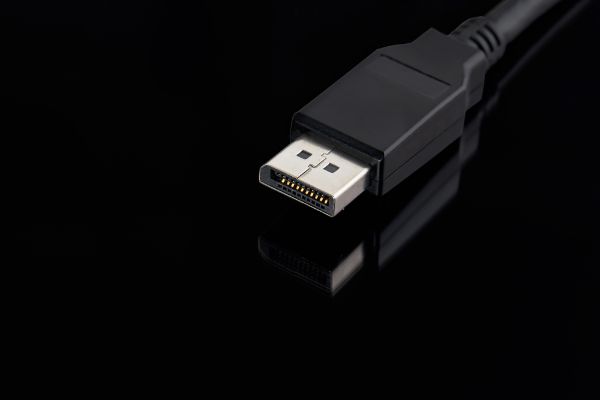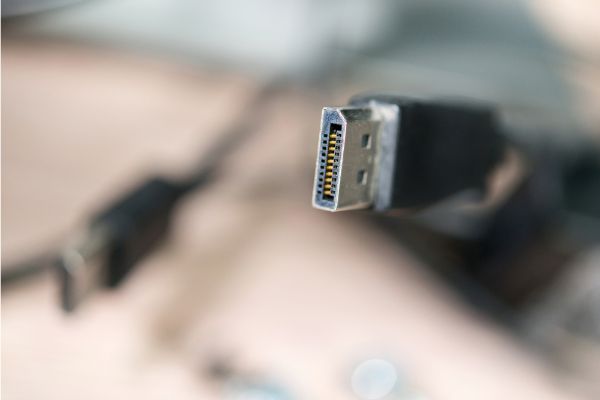Disclaimer: This post may contain affiliate links, meaning we get a small commission if you make a purchase through our links, at no cost to you. For more information, please visit our Disclaimer Page.
DisplayPort is a specific audio and video standard, and there are special cables you would need to use in order to transfer data between one device and another using this standard. You’ll find DisplayPort most commonly on desktops or laptop computers, but it isn’t unusual to find it as one of the primary ways you can access larger projectors, too.
Much like any other cable that is meant to plug into ports on a device, they will have specific inputs, and they aren’t interchangeable with other audio-visual cables.
Because these things transfer data, some people wonder if they can just go bad or stop working altogether. We will touch on whether DisplayPort cables can malfunction in such a way as to be inoperable, how delicate they might be, and some of the reasons why your own DisplayPort cable might not work properly.
Furthermore, we’ll see if there are any telltale signs that a cable is bad or going bad, and we’ll talk about tests you might be able to run to confirm this.
Table of Contents
Can DisplayPort Cables Go Bad?
Although it is unlikely, DisplayPort cables can go bad sometimes. Additionally, you could get stuck with a cable that is faulty, too. This means that it would refuse to work properly right from the start.
Like any cable, the DisplayPort one has connectors that allow it to bridge the gap between a device meant for video and the monitor that is supposed to display everything. Consistent plugging or unplugging of the connectors might damage the pins inside them over time. Again, this is not necessarily common, but it is a possibility to watch out for when you are using your DP cables frequently.
Similarly, it is important to make sure that you plug them straight into the appropriate port. You should also unplug them the same way, using a firm tug that does not wiggle the connectors around too much. Anything else could cause some issues with the pins or put stress on the connectors.
This is because the design allows for a straight connection, but too much side motion or wrenching the connector out of the port can cause the pins to bend. While this might not be the case if you only do this a few times, the stress can add up over time. This is not a guarantee against failure, but it can help the cables last as long as possible.
Are DisplayPort Cables Fragile?
There are some exceptions, but it is not common for DisplayPort cables to be fragile. They need to handle a constant flow of data, and they are designed for frequent plugging or unplugging as needed.
We touched on the ports and connectors themselves earlier, and these would be the most likely areas where you might experience flimsiness. Proper cables in this interface tend to use good materials that should stand up to a lot of use, and they should last a long time if you use them correctly.
All that said, it is always a good idea to go for cables made by reputable brands that are supposed to be of decent quality. Most good cables for DisplayPort are not terribly expensive, even if you have budget constraints that you want to meet. Furthermore, it is true that very cheap cables from sources you’ve not heard of might use inferior parts.
This could make them fragile, and you might find that they are prone to failures. If you get these kinds of failures often, you could be looking at several errors in how your audio, video, or both are processed on the screen of your choice. At best, frequent plugging and unplugging would be necessary here. It is always preferable to go with some mid-range cables to get ones of good quality that are robust.
Why Is My DisplayPort Cable Not Working?
Even with cables that are of good quality, you could find that yours do not function as they should. There are a few reasons why this might be. Although our list is not comprehensive, we will look at some of the most common causes of nonfunctional DisplayPort cables. We’ll also go over how you might restore them to working order.
1. There is an improper connection between the devices. Check to see if anything is loose or wobbly. You may want to unplug the cables at both ends and plug them back in again to see if this fixes the issue. For a proper connection, you should feel the pins on the cables lock into place in such a way that they require some force to remove.
2. There could be a simple data transfer problem that is not the fault of the cables themselves. A simple restart of your devices could fix this issue.
3. If a restart does not work, you may want to check the drivers for your devices. Drivers are a big part of what tells the devices how to function, and if they are not working or updated, there could be a problem. Check for updates to the drivers on the device of your choice. If this does not work, you may want to uninstall and reinstall said drivers.
4. Conversely, you can try rolling back the drivers if the cables and connections did seem to work fine recently. Some driver updates cause errors, and a rollback can help to alleviate these issues. You can keep using the older drivers until the developer fixes the bugs in the new ones.
5. If everything seems like it should be working fine, you may be dealing with improper input sources. Some of the monitors to which you can connect your cables may have more than one input source for DisplayPort. If this is the case for you, make sure the correct one is selected, and double-check to ensure that it corresponds to the input into which you’ve plugged your cable.
What Are Some Signs of a Bad DisplayPort Cable?
There are times when a DisplayPort cable simply isn’t working, but you might be dealing with one that has gone bad altogether. In such cases, it is less likely that some of the fixes we went over above will work. Full replacements of the cables may be necessary here. There are a few signs you can watch out for to know if your cables might be going bad:
1. If the display on the monitor of your choice is flickering in and out, it could be a sign that the cable is faulty or going bad.
2. Similarly, you may get tears or artifacts on the screen. Although this could point to a problem with your graphics driver itself, it is also something that will crop up if the DisplayPort cable is bad. Check your graphics card settings and load first, but it is possible that you’ll need to replace these cables.
3. If audio, video, or both seem to be out of sync with each other constantly, your DP cable might be failing.
4. If you are experiencing a much lower than normal refresh rate on your screen, it could be a sign that there is a problem with the DisplayPort cable.
5. General error messages that the cable or connections fail to work could also point to this problem.
How Can I Test My DisplayPort Cables?
There are a few ways that you might test the cables just to make sure they are the culprits of your woes. Some of the things you can do are quite general in nature, and they should work with any of the issues we touched on above. However, there might be specific steps you need to follow if you need to figure out if the issue is one of software rather than the DisplayPort technology.
One of the easiest ways you can test your DisplayPort cable is to plug it into devices you don’t use often. If you have other monitors, plug it in here and see if there are still issues that crop up. If so, the problem may be the cables.
However, to get down to it, you may want to connect the cables to other devices that act as sources, too. Doing both of these things can help you see if the problem is either the monitor or the device. If both still have issues, it is more likely to be something to do with the cable.
The other thing you can do is test a different cable. If things work fine, you can be pretty sure that the original cable you wanted to use is at fault. It’s never a bad idea to have at least one spare cable on hand for these purposes.
Furthermore, you can perform more pointed testing by going through the list of errors we mentioned above to see if one of those fixes solves the issue. If that is the case, your cable may be fine.
Conclusion
DisplayPort is a useful interface, but it can be prone to some connectivity errors from time to time. The cables themselves should be fine, but it is best to buy from reputable dealers who make theirs from quality components. If you do find that you are having some problems, there are specific tests you can run to determine if a replacement cable is necessary.


